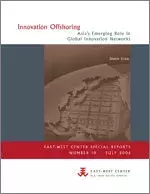
Most analysts agree that critical ingredients for economic growth, competitiveness, and welfare in the United States have been policies that encourage strong investment in research and development (R&D) and innovation. In addition, there is a general perception that technological innovation must be based in the United States to remain a pillar of the American economy. Over the past decade, however, the rise of Asia as an important location for "innovation offshoring" has begun to challenge these familiar notions. Based on original research, this report demonstrates that innovation offshoring is driven by profound changes in corporate innovation management as well as by the globalization of markets for technology and knowledge workers. U.S. companies are at the forefront of this trend, but Asian governments and firms are playing an increasingly active role as promoters and new sources of innovation. Innovation offshoring has created a competitive challenge of historic proportions for the United States, requiring the nation to respond with a new national strategy. This report recommends that such a strategy include the following elements:
| Additional titles in the East-West Center Special Reports series
|
Most analysts agree that critical ingredients for economic growth, competitiveness, and welfare in the United States have been policies that encourage strong investment in research and development (R&D) and innovation. In addition, there is a general perception that technological innovation must be based in the United States to remain a pillar of the American economy. Over the past decade, however, the rise of Asia as an important location for "innovation offshoring" has begun to challenge these familiar notions. Based on original research, this report demonstrates that innovation offshoring is driven by profound changes in corporate innovation management as well as by the globalization of markets for technology and knowledge workers. U.S. companies are at the forefront of this trend, but Asian governments and firms are playing an increasingly active role as promoters and new sources of innovation. Innovation offshoring has created a competitive challenge of historic proportions for the United States, requiring the nation to respond with a new national strategy. This report recommends that such a strategy include the following elements:
| Additional titles in the East-West Center Special Reports series
|







